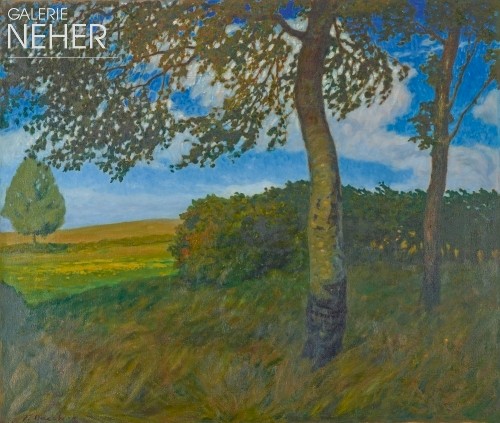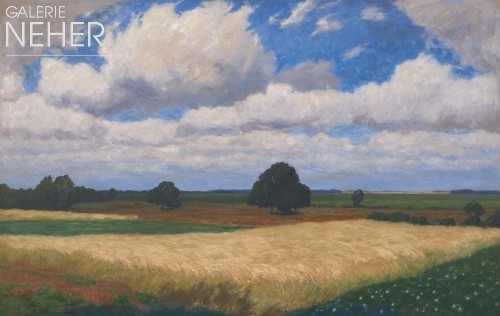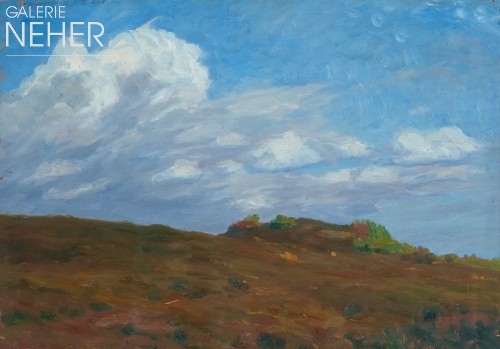Fritz Overbeck
* 15 09 1869 | Bremen
† 08 06 1909 | Broecken near Vegesack
Fritz Overbeck died young and was viewed by the founding fathers of the Worpswede artist colony as the natural scientist and unsentimental realist. He achieved recognition with wonderful landscapes from the Teufelsmoor, with beach and dune paintings from Sylt and with mountain views from the Swiss Alps. His expert etchings are also of a special intensity and quality.
Works by Fritz Overbeck
Vita Fritz Overbeck
1869
Born on 15 September in Bremen as August Friedrich Overbeck.
1881–89
Attended the Altes Gymnasium in Bremen.
1883/84
Had his first private drawing lessons.
1889–93
Studies at the Kunstakademie Düsseldorf. Overbeck was a member of the student artist association Tartarus, to which Otto Modersohn, Fritz Mackensen and Heinrich Vogeler also belonged.
1892
Cruise in Norway along the fjord coast.
First summer stay in Worpswede, where Fritz Mackensen and Otto Modersohn had already settled.
1893
He attended the master class for landscape painting with Eugen Dücker at the Kunstakademie Düsseldorf.
Stay in Berlin and Dresden with Otto Modersohn. Second summer stay in Worpswede from May to September.
1893/94
Military service in Bückeburg.
1894
Move to Worpswede in October, founding of the Worpswede artist association in December together with Hans am Ende, Fritz Mackensen, Otto Modersohn and Heinrich Vogeler.
Together they published the etching portfolio Aus Worpswede (From Worpswede).
The flat, expansive plain became his preferred landscape motif. Here he painted, often a stickler for details and precision, and in earthy, lush and glowing colours, the uninhabited, expansive countryside, the meadows and fields, the moor cots and canals, the Hamme river and the Weyerberg island, the birches and the mighty clouds towering over the countryside at various times of day and in different seasons.
1895
First exhibition of the artist association in the Kunstverein in Bremen; participation in the Münchener Jahres-Ausstellung von Kunstwerken aller Nationen im Königl. Glaspalaste. Overbeck exhibited three paintings and six etchings there.
Military service in Flensburg.
He moved into his studio at the sand pit on the Weyerberg island in Worpswede.
1896
Travel to Munich with the artist colleague Eduard Euler.
1897
Overbeck is awarded the Grand Golden Medal of the VII. Internationale Kunstausstellung im Königlichen Glaspalaste München 1897 and the Small Golden Medal of the Internationale Kunstausstellung in Dresden.
Marriage with the painter Hermine Rohte (1869–1937) in October, who had come the year before to Worpswede as his pupil.
1898
Birth of their son Fritz Theodor.
Travel to Amsterdam with Otto Modersohn, Fritz Mackensen and Clara Westhoff.
1899
After Otto Modersohn, Heinrich Vogeler and Fritz Overbeck also left the Worpswede artist association.
1900
Trip to Paris with his wife, Otto Modersohn and Marie Bock to visit Paula Becker and Clara Westhoff. Cancellation of the trip due to the sudden death of Otto Modersohn’s wife Helene.
Birth of their daughter Anne, who died only a few days later.
1903
Birth of their daughter Gerda.
In September, the first study trip to Sylt, where he produced numerous oil studies of the beach, dunes and ocean waves in this year and during subsequent stays, which are distinguished by compositional reduction and a colour palette that is brighter than that of the Worpswede paintings.
1904
Renewed stay on Sylt.
He visited his wife Hermine Overbeck-Rohte, who was suffering from a lung disease, in the sanatorium in Oberkaufungen.
An occasional turn to the figurative can be determined in his painting.
1905
Move to Bröcken near Vegesack (today part of Bremen). The change of location inspired him to an artistically fruitful period, in which he created more than half of his oeuvre before his death in 1909. He found new motifs in the meadow landscape of the near vicinity and painted the garden of his house Sechslinden. However, the focus of his painting also shifted once more to Worpswede.
Overbeck received the Golden Medal of the Nordwestdeutsche Kunstausstellung.
1906
A stay in the Rhön mountains during the summer, where he discovered new motifs for his art.
1907
Trip to Norderney in January, to Düsseldorf in April. Third study residence on Sylt in September.
Overbeck turned to the still life genre for the first time.
1907/08
President of the Nordwestdeutscher Künstlerbund.
1908
Stay in Klosters near Davos, where he visited his wife Hermine in the Sanatorium Davos. He captured the Grisons Alps in more than 40 winter studies, which were elaborated into large-format paintings in the studio upon his return.
1909
Trip to Berlin in February.
Fritz Overbeck died of a stroke at only 39 years old in Bröcken near Vegesack.


